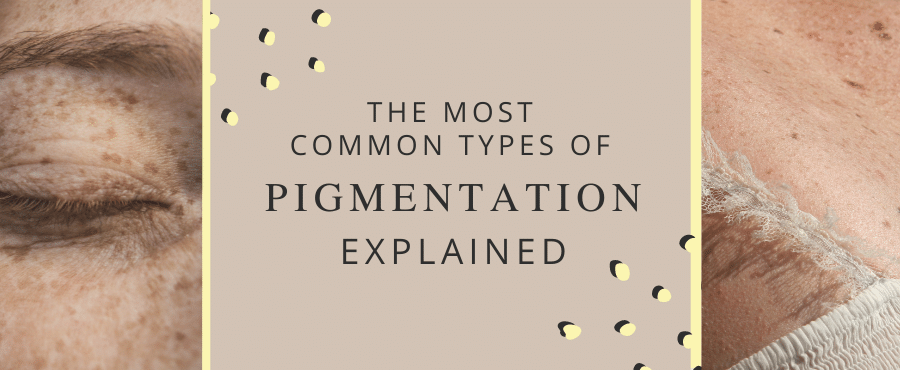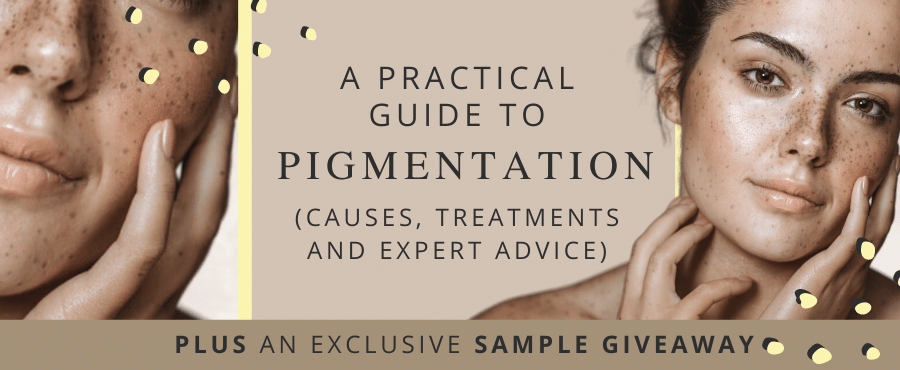
Pigmentation and sun damage is one of the most common skin concerns we see in the clinic. If you’re starting to notice dark patches on your face or body, take a look at our comprehensive guide to help identify exactly what your pigmentation could be.
Post Inflammatory hyperpigmentation (PIH)
What is postinflammatory hyperpigmentation?
Post-inflammatory hyperpigmentation is the appearance of pigment which is darker than the pigment in your natural skin colour. The shade of this darker pigment can range from very light and barely noticeable to very dark and highly visible. In some cases, this type of pigmentation can naturally fade over time but if yours is showing no signs of change then without treatment the pigmentation could be permanent.
What causes postinflammatory hyperpigmentation?
If you have this type of pigmentation, you’ll probably know exactly where it came from as it usually appears in areas where the skin has been damaged. This could be a result of an injury to the skin such as a cut or surgical procedure or it could be damage to the skin caused by another skin condition such as eczema or dermatitis in which case the hyperpigmentation could cover a much wider area of your face or body. Those with active, outdoor lifestyles particularly with a passion for outdoor spots such as cycling or watersports can be prone to more prominent damage due to the increased exposure to sunlight. Another common cause can be breakouts which have left pigmentation marks.
Who gets postinflammatory hyperpigmentation?
We’re all vulnerable to suffering from this type of pigmentation however the condition is often more visible if you have darker skin as the change in pigmentation can appear more noticeable. You may notice this pigmentation darkening in the summer as it’s susceptible to sunlight or you may have even noticed a darkening of your pigmentation after a course of medication as some medications list this as a side effect.
Melasma
What is Melasma?
Melasma is another form of visible hyperpigmentation on the skin, those of us suffering from Melasma will most often find patches of darker pigmentation on areas which are most vulnerable to the suns UV rays. This commonly includes the forehead, nose, cheeks, chin and top lip. While facial Melasma is common, it can actually appear on any area of the body so you may have patches of darkened pigmentation on the shoulders, chest or back. This condition is affected by sunlight and can appear to intensify in the summer and fade in the winter.
What causes Melasma?
Significant hormonal changes can cause the condition to appear seemingly from nowhere which can be a very unsettling experience. Hormonal changes include puberty, pregnancy and of course the menopause. In addition to hormonal changes, Melasma can also be a genetic condition which means we can experience melasma at any stage of our lives purely because it runs in our family.
Who gets Melasma?
Due to the hormonal trigger of melasma, Women are most commonly associated with the condition however men can suffer from melasma as well. Melasma affects women and men of all skin types however as with most pigmentationary conditions those with dark skin often find the condition to appear more noticeable.
Age / Sun Spots / Café au lait
What are age / sun spots
There are several terms related to age spots including sun spots, liver spots and solar lentigines. They are incredibly common and something that many of us will notice at some stage in our lives. The appearance of these spots will usually be flat and can range in size but are usually fairly small. They are a light to dark brown colour, darker than the rest of our skin. Age or Sun Spots can really bother us as often they appear on areas of our face or body which see the most sun so parts of the skin which are highly viable.
What causes age / sun spots
Our skin contains cells known as ‘pigment cells’ these cells both absorb light and regulate pigment which together determines the colour of our skin. Age or sun spots are caused when we have a group of cells which are ‘overactive’ meaning they are absorbing more light and processing the colour of our pigment at a faster rate than other pigment cells. This results in small patches or spots of visibly darker pigment. When we expose these overactive cells to sunlight, they can become even darker as a result of these cells working at a quicker pace than the surrounding cells. This form of pigmentation does not fade and increased exposure will result in the pigment becoming darker.
Who gets age / sun spots
As the name suggests, age spots are a condition which develop as we get older, this is due to the increased duration of sun exposure to the skin. In our clients we most often see clients in their 30s plus seeking treatment for age / sun spots but we have treated several clients in their 20s especially those who have used sunbeds or spend lots of time outside for work or leisure.
Uneven Skin Tone
What is uneven skin tone?
Uneven skin tone is one of the most common concerns at the clinic and often clients don’t realise that this is actually a form of hyperpigmentation. Without a careful skincare routine and regular aesthetic treatments, most of us will find variety in the colour of our skin.
What Causes Uneven Skin Tone?
There are several causes to uneven skin tone but the primary cause is sun damage, this is why we often find that clients coming to the clinic with this concern will have the lightest areas around the hairline and the darkest areas on parts of the face which take the most sunlight such as forehead, cheekbones, nose, lip and chin.
Who gets uneven skin tone?
Uneven skin tone can affect us all but those who are not wearing SPF sun protection effective against UVA and UVB sunlight will be most vulnerable to this condition. If you routinely wear sun protection when the weather is hot and cover your skin you may wonder why you have the condition however many of us don’t know that we need to be taking these precautions all year round regardless of the intensity of the sun as UV rays and other UV exposure happens all year round.
Want to know how to overcome your condition?
Take a look at our ‘Practical Guide To Pigmentation: The things you need to KNOW and DO to prevent and overcome pigmentation damage.’
Book A Consultation
Your journey to skin free of pigmentation damage starts here. Book your free consultation and let our experts build your bespoke treatment plan today.


